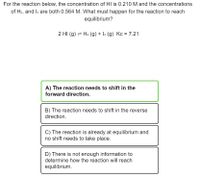
Chemistry
10th Edition
ISBN: 9781305957404
Author: Steven S. Zumdahl, Susan A. Zumdahl, Donald J. DeCoste
Publisher: Cengage Learning
expand_more
expand_more
format_list_bulleted
Question
thumb_up100%

Transcribed Image Text:For the reaction below, the concentration of HI is 0.210 M and the concentrations
of H2, and l2 are both 0.564 M. What must happen for the reaction to reach
equilibrium?
2 HI (g) - H2 (g) + l2 (g) Kc = 7.21
A) The reaction needs to shift in the
forward direction.
B) The reaction needs to shift in the reverse
direction.
C) The reaction is already at equilibrium and
no shift needs to take place.
D) There is not enough information to
determine how the reaction will reach
equilibrium.
Expert Solution
This question has been solved!
Explore an expertly crafted, step-by-step solution for a thorough understanding of key concepts.
This is a popular solution
Trending nowThis is a popular solution!
Step by stepSolved in 2 steps

Knowledge Booster
Learn more about
Need a deep-dive on the concept behind this application? Look no further. Learn more about this topic, chemistry and related others by exploring similar questions and additional content below.Similar questions
- 12. A 2.50 L vessel contains 1.75 mole N₂, 1.75 mol H₂ and 0.346 mole NH3. What is the direction of reaction needed to attain equilibrium at 401 °C? The equilibrium constant Kc for the reaction is 0.50 at this temperature. N₂(g) + 3H₂(g) 2NH3(g)arrow_forwardEnter your answer in the provided box. The equilibrium constant for the reaction is 6.8 × 103 at a certain temperature. 2SO2(g) + O2(g) = 2SO3(g) If at equilibrium, [SO2] = 0.0611 M and [GE] = 0.07 M, what is the equilibr 1.33 Xarrow_forward1arrow_forward
- Based on the information below, calculate the equilibrium concentration of B (g). 4A (g) + B (g) ----> 2C(g) Kc=5x10-24 Initial concentration of A= 0.10 M Initial concentration of B=0.34 M Initial concentration of C=0.80 Marrow_forward5) For the reaction shown below, at a particular time, the following concentrations are obtained: [CO] = 0.034 M, [CO2] = 3.6 x 10-17 M. Is this reaction at equilibrium? If not, which direction will the reaction proceed and what will the concentrations be at equilibrium? 2 CO (g) « C (s) + CO2 (g)Kc = 7.7 x 10-15arrow_forward4. Given the reaction: 3X(g) + Y(g) ↔ 2 Z(g) + W(g)Which of the following is true?a. Kc > Kpb. Kc < Kpc. Kc = Kp5. For the reaction: 2 X(s) + 3 Y(g) ↔ 2 Z(s) Kc = ???At equilibrium, the system contains [Y] = 0.0025 M. The amounts of [X(s)] = 100 mol/Land [Z(s)] = 395 mol/L. What is the value of the equilibrium constant?6. For the reaction: 3A(g) + 2B(g) ↔ 3 C(g) Kc = 0.0245At equilibrium, the system contains [A] = 0.075 M and [B] = 0.115 M. What is theconcentration of C at equilibrium (in M)?7. Given the reaction A(g) + 3B(g) ↔ 2 C(g) Kc = ???Initially, only 0.200 M of C(g) is present. At equilibrium, 0.050 M of A is present. What isthe value of the equilibrium constant?arrow_forward
- At equilibrium, the concentrations in this system were found to be [N,] = [O,] = 0.200 M and [NO] = 0.500 M. N2(g) + O2(g) = 2 NO(g) If more NO is added, bringing its concentration to 0.800 M, what will the final concentration of NO be after equilibrium is re-established? [NO]inal Marrow_forward5.For the following equilibrium reaction: Energy + 2AB2 (g) 2 AB (g) + B2 (g) where K = 55 What will happen to the amount of B2 (increase, decrease or stay the same) if a catalyst is added some AB is removed temperature is increased pressure is increased the amounts of AB2 and AB are kept constant while the value of K is decreasedarrow_forward
arrow_back_ios
arrow_forward_ios
Recommended textbooks for you
 ChemistryChemistryISBN:9781305957404Author:Steven S. Zumdahl, Susan A. Zumdahl, Donald J. DeCostePublisher:Cengage Learning
ChemistryChemistryISBN:9781305957404Author:Steven S. Zumdahl, Susan A. Zumdahl, Donald J. DeCostePublisher:Cengage Learning ChemistryChemistryISBN:9781259911156Author:Raymond Chang Dr., Jason Overby ProfessorPublisher:McGraw-Hill Education
ChemistryChemistryISBN:9781259911156Author:Raymond Chang Dr., Jason Overby ProfessorPublisher:McGraw-Hill Education Principles of Instrumental AnalysisChemistryISBN:9781305577213Author:Douglas A. Skoog, F. James Holler, Stanley R. CrouchPublisher:Cengage Learning
Principles of Instrumental AnalysisChemistryISBN:9781305577213Author:Douglas A. Skoog, F. James Holler, Stanley R. CrouchPublisher:Cengage Learning Organic ChemistryChemistryISBN:9780078021558Author:Janice Gorzynski Smith Dr.Publisher:McGraw-Hill Education
Organic ChemistryChemistryISBN:9780078021558Author:Janice Gorzynski Smith Dr.Publisher:McGraw-Hill Education Chemistry: Principles and ReactionsChemistryISBN:9781305079373Author:William L. Masterton, Cecile N. HurleyPublisher:Cengage Learning
Chemistry: Principles and ReactionsChemistryISBN:9781305079373Author:William L. Masterton, Cecile N. HurleyPublisher:Cengage Learning Elementary Principles of Chemical Processes, Bind...ChemistryISBN:9781118431221Author:Richard M. Felder, Ronald W. Rousseau, Lisa G. BullardPublisher:WILEY
Elementary Principles of Chemical Processes, Bind...ChemistryISBN:9781118431221Author:Richard M. Felder, Ronald W. Rousseau, Lisa G. BullardPublisher:WILEY

Chemistry
Chemistry
ISBN:9781305957404
Author:Steven S. Zumdahl, Susan A. Zumdahl, Donald J. DeCoste
Publisher:Cengage Learning

Chemistry
Chemistry
ISBN:9781259911156
Author:Raymond Chang Dr., Jason Overby Professor
Publisher:McGraw-Hill Education

Principles of Instrumental Analysis
Chemistry
ISBN:9781305577213
Author:Douglas A. Skoog, F. James Holler, Stanley R. Crouch
Publisher:Cengage Learning

Organic Chemistry
Chemistry
ISBN:9780078021558
Author:Janice Gorzynski Smith Dr.
Publisher:McGraw-Hill Education

Chemistry: Principles and Reactions
Chemistry
ISBN:9781305079373
Author:William L. Masterton, Cecile N. Hurley
Publisher:Cengage Learning

Elementary Principles of Chemical Processes, Bind...
Chemistry
ISBN:9781118431221
Author:Richard M. Felder, Ronald W. Rousseau, Lisa G. Bullard
Publisher:WILEY